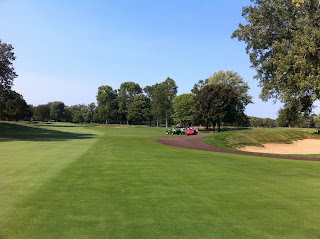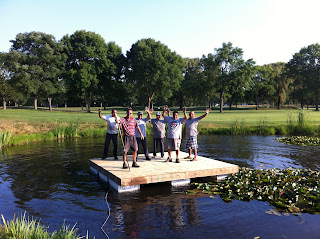With the dog days of August past, and Labor Day's Club Championship "in the books", it's now time we turn our attention to various late summer / fall tasks as well as a few more involved projects.
We began the task of aeration, on the greens, on Tuesday after Labor Day. We used a small diameter, closely spaced, solid tine, which left only minimal surface disruption which today, Friday, three days later, is barely visible. We performed this task to relieve compaction from the twelve days of straight rolling, as well as to provide several other important benefits such as; to improve air movement and gas exchange from the rootzone; provide avenues for new root growth; and to plant new seed in any areas that were thin from the summers many stresses. This isn't the last time we will do this aeration work, this season, as plans are to use a slightly larger diameter tine in early Oct. and then a larger tine yet in mid to late Oct. I'll keep you posted as to when these tasks will be addressed as we get a little closer to Oct.
In the coming weeks we'll also be performing other maint. tasks, some of which are done regularly throughout the year (like greens topdressing every two weeks) and others, performed during these cooler, less busy, post Labor Day period, such as tee aeration, and fairway aeration and sand topdressing. Additionally, our fall project list includes: Fairway Expansion, Green Surround Repair, Rough Improvement - Bentgrass Control & Overseeding, Chipping Area Leveling and Expansion, and a bit later on, Bridge Reconstruction. I'll cover all of these projects in this blog (periodically) as we work on them, and will Tweet activity several times daily so if you're inclined follow me on Twitter @scc1897.
We've actually started three of the above projects but at this time I just want to address the Fairway Expansion work we have done on Hole #11 and started on hole #4.
When we did our course restoration back in 1999-2001, Fairway Repositioning and Expansion was one of the objectives of our Architect, Ron Prichard. We repositioned several and added about 1 1/2 acres of fairway turf. At the time this was all purchased bentgrass sod, and as an aside, it looked noticeably different from our mixed bentgrass/poa annua turf, for many years. Cost was quite high and so many areas did not get the expansion that Ron originally envisioned. And I do think his thoughts have since evolved to where he feels more of this expansion would benefit, as well as challenge, players of all levels. Our plan at that time was to cut most of the proposed expansion areas, which includes areas close to the front sides or leading edges of bunkers, as well as the areas behind or the shoulder areas behind bunkers, as intermediate rough and plan to eventually convert these areas to fairway turf over time. Many areas have since been addressed in this manner and include #3 left side, #4 near approach bunkers, #7 near bunker on left and at green, #8 near bunker rt. side near green, and #9 in approach area. All of these expansion areas generally open up options for different routes of fairway play and some likely make players think a bit more before hitting too close to certain bunkers that perhaps now a ball might not have as large an area of rough in front which formerly may have helped stop a ball from entering. These expanded areas may give a bit more relief to a wayward shot but might also bring tall rough a little close into play. Where the back shoulders of bunkers have been converted to fairway turf, a ball that challenges a bunker (which may be a more direct line to the green) and successfully clears it, is now "rewarded" with a nice roll further down the fairway rather than hanging up and stopping in the taller rough. Basic Risk / Reward at it's finest!
Several Expansion Areas remain throughout the course and you can see where we will eventually convert by looking at the width of the intermediate or short grass rough surrounding the fairways. Eventually we will have just a single width mower pass of 5' or less surrounding all fairways, except for a few areas at beginning of fairways such as #2. The wider areas toward the inside of the fairways will be converted from intermediate bluegrass/ryegrass to our own fairway turf of bentgrass/poa annua.
Back in 1999 I grew an entire 10,000 sg. ft. nursery (it's in the area between 7&8...been reestablished 2 more times since for green expansions and fairway repairs) from aeration cores collected from the greens. It's a simple and effective plant propagation technique that I had used twenty years prior to establish new bentgrass tees at a former golf course I managed. I actually had learned that this technique worked as a grounds crew worker at a country club during the summer of my college years. We had some damaged areas on the fairways and so we aerated healthy areas, collected cores, and spread and tamped them into the damaged areas. In a short time we were mowing and the damage was soon recovered. Since this time I've used this same technique to establish more nursery greens, ultimately used to expand nearly all of our greens over time, as well as to establish the entire greens of #5 and #11. It is high successful and aside from being relatively quick, it's inexpensive, and most importantly, the resulting turf is an exact match of the turf species in the "donor" area. In other words the turf in the expansions will look the same, perform the same (for better or worse), play the same as the original green or, in this case, fairway area. Using new seed or new sod, aside from taking longer to establish -seed, or costly significantly more money - sod, will most certainly yield a surface dissimilar to our existing fairway surfaces.
Our work on #11 Fairway Expansion (in photos) follows:
Wide intermediate rough behind cross bunkers at #11
Sod removal begins and all quality sod is used in other course locations where needed.
Expansion closer to green (photo looking from #11 Green back).
Area with majority of sod removed.
One of the the recipient areas of intermediate sod, alongside cart path behind #11 Green.
With sod removed we run aerator several times to loosen soil in prep for receiving cores.
Aerating the fairway area adjacent to expansion area.
Collecting cores using snow shovels.
Spreading thin layer of cores (2-3 cores thick) in aerated, fertilized area.
"Dimpling" cores into surface with "knobby" tires of bunker rake machine (also not show was small amount of bentgrass seed dropped prior to dimpling process) to insure good soil contact, followed by a thorough watering.
Roped off and ready to begin establishment.
Close-up of cores and seed beginning to sprout less than a week later!
About 10 days after planting. Beginning to show nice progress.
Close-up of first area planted. Day 16
First mowing, 16 days after planting. Area looks like fully established from this short distance but will be a few more weeks before fully established and play is allowed. Great progress though!
Next area underway is at first bunker on right side of hole #4
Fairway will be expanded and brought up higher on back shoulder.
Sod removed and soil prepared.
First area of cores in place, seeded, and dimpled.
Since this last picture was taken we have had a few days of rain causing the bare soil area to become too wet on surface to continue this work. We will resume early next week and complete this right side area and then follow with the left side bunker area directly opposite area shown in this above photo. Several other areas will still remain for this expansion work. We would like to expand another area or two but a few other projects are underway which will soon take precedence as the prime turf growing season wanes including; Green Surround Repair (replacement of damaged and/or multiple turf species contamination surrounding the Green surfaces, #11 and #13 already completed), Rough Improvement (controlling bentgrass contamination and overseeding) and Expansion and Leveling of the Chipping Area. More on all of these projects very soon. Keep close tabs by following on Twitter @scc1897.

















































